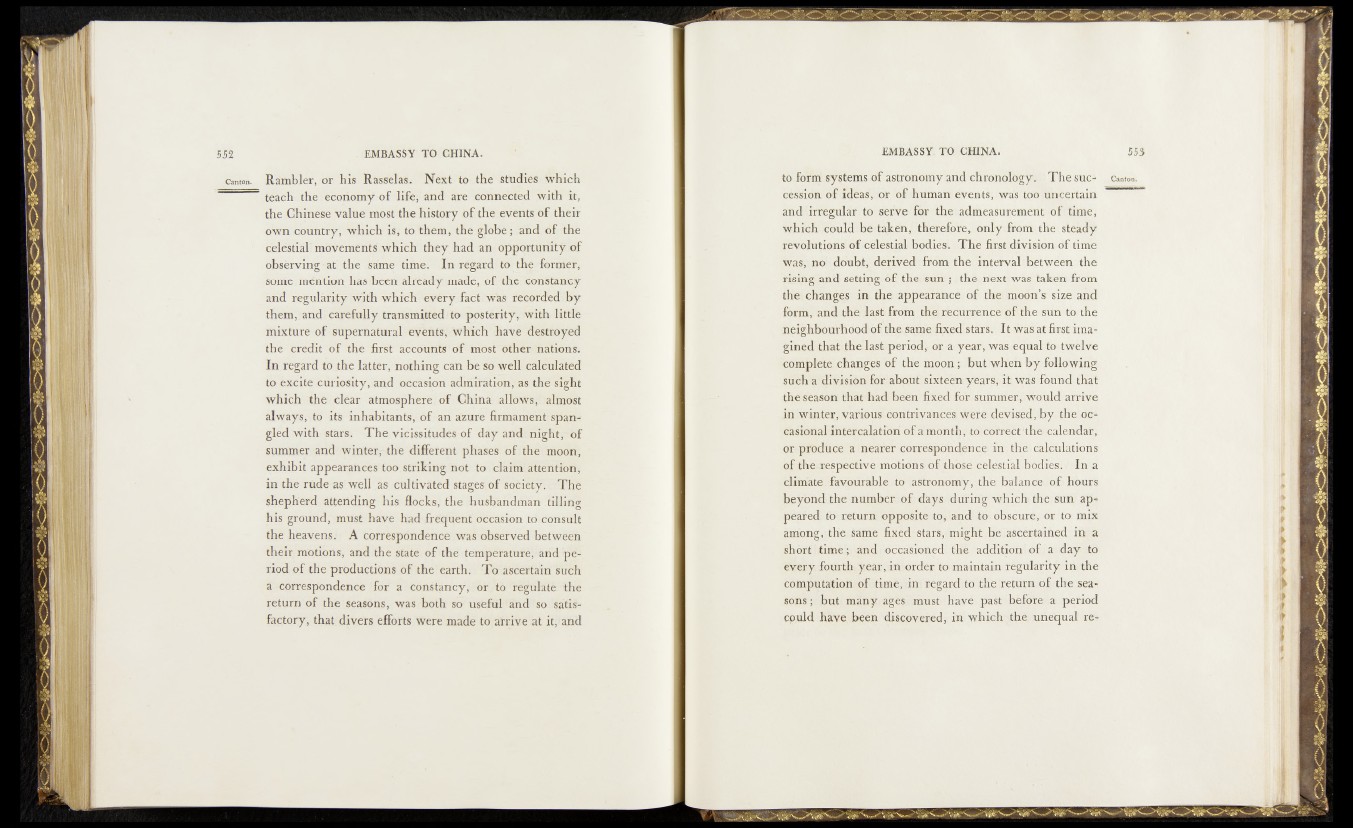
canton. Rambler, or his Rasselas. Next to the studies which
teach the ■ economy of life? and are connected with it,
the Chinese value most the history of the events of their
own country, which is, to them, the globe ; and. o f thé
celestial movements which they had an opportunity of
observing at the same time. In regard to the former,
some .méntion has been already made, of the constancy
and regularity with which every fact was- recorded ) by
them,, and; carefully transmitted to posterity,; with little
mixture of supernatural events, which have destroyed
the credit of the first accounts of most other-nations;
In regard to the latter, nothing can be so well calculated
to excite curiosity, and occasion admiration, as thé sight
which the <■ clear atmosphere of China allows, almost
always, to its inhabitants, of an azure firmament*spangled
with stars. The vicissitudes of day and: night;?6'f
summer and winter, the different phases of the moon,
exhibit appearances too. striking not to claim!attention,
in the rude as well as cultivated stages, of söèiet&. . The
shepherd attending his flocks, the husbandman .tilling
his ground, must have had frequent occasion jöiconsult
the heavens. A correspondence was observed betwêéfe
their motions, and the sfaté of the temperature, and »period
of tile productibns of the earth. To ascertain such
a correspondence for a constancy? tô regtdate?flife
return of the seasons, was both so useful and so satisfactory,
that divers efforts were made to arrive .at it? and
to form1 systems o f astronomy and chronology.*. T h e sue-*
©éi&idm o f ideas, -of o f fhumarf évents, wa"srtbb|ühCertain
and 'irregular to serve for the admeasurement" o f time,
which could betaken, therefore, only from the. steady
révolutions, o f celestial bodies. T he first division o'f time
Wa&ÿ: no doubt, derived from the. interval, bet ween the
rising and setting o f the,,sun ; thiunext!was taken from
the s changes in the appearance o f thermodu’s sjy è'land
for fit, and thé last, from thej^bo^^uÊ^fithe sun tb. the
neighbourhoqd ô f the same fixed stars-. It was at first ima-
ginedsthat thedast period, or a year,w à s equahtebtwelve
complete changes o f the m o on ;,but when b y following!
such a division for about sixteen! years ;ib. was found that
the season’ that'had been fixel^objsummer^Vrould arrivé
in winter, various,contrivancé^wefé^dieiyi^âlMyJtKe occasional
intercalation o f a month? to l^ fe ltA h e 'calen'd^;
or prbdirce a near'er correspondpBMBm4tjh;éi(^fenEations
o f theftrespective motions o f those célgstikl bddÿè&. In a
climate, favourable,,to astronomy, sthqlbadâncé’ of hours
beyond'the number of days .during w h ich the'sun appealed,
fib return, opposite toiiànd to,v^pG'Btr.e-,''iMfto mix
among, the same fixed" stars ,dmight be ascertained";in a
short time; and• occasioned! the addition iof a day ;tb
every fourth, year, ànaordéc mrniàintaihifsègülaTi'ty’âfls.the
computation o f time, -inr regard to thelretum,of\t'&e(sea-.
sons; but manyi'agêskruustbhayé;pastboforeba.period
could hâve, been discovered, in whieh^théjnnefpialurè